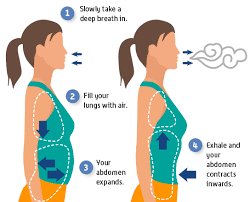The fear of public speaking can be so strong that our bodies respond to it as if it were a life or death situation. Often when getting ready to do a presentation or public speaking, your body will lock up, causing you to go into fight or flight mode.
The stakes of your presentation may be high. Finding a sense of calm is crucial so that you can do your job well. Remember the free throw analogy in part one? Check out the link here. You don’t want to be a deer in headlights, right? Next time you are feeling stressed about a presentation or you want to simply practice, start with a supportive breath free from bad habits.
The following are a few breathing exercises you should work on to connect to your supportive breath.

How to start with a low, supportive breath from your diaphragm or your low belly.
- Stand on your two feet, hip width apart.
- Feel your feet on the floor. Really feel them.
- Place a hand on your low belly, your diaphragm.
- Start to think about breathing from your diaphragm.
- Try not to move your shoulders as you breathe.
Can’t find your breath? That’s okay, finding a supportive breath for the first time can be difficult and finding a supportive breath when you are nervous takes time. Try this:
- Stand with your feet wide apart.
- Bend your knees deeply. (like a mini-squat)
- Place your hand on your low belly and your low back.
- Stay in this position for as long as you can.
- Feel your low belly and even your back extend with each breath.
Want to connect further to your body through breathing? If you you are able, try this:
- Stand with your feet hip width apart.
- Feel your feet on the floor. Really feel them.
- Roll down vertebrae by vertebrae, starting with your head to your chest
- Your feet still feel the floor beneath you.
- Continue to roll down until you are folded over.
- Let your arms go.
- Breath from your diaphragm.
- Stay there for a while.
- Once you find your supportive breath, slowly roll back up one vertebrate at a time.
- Your head will be the very last thing to come up.
Breathing with awareness should never cause tension. It should help your body loosen up when you are feeling stressed. Whether you are having trouble engaging your supportive breath and/or you have found your supportive breath but feel tense, try this:
- Stand on your two feet hip width apart.
- Let go to your sides.
- Start to lightly bounce by bending your knees.
- Let your hands go.
- Let your hands and arms lightly swing/bounce with your body.
- Let your shoulders bounce with your body.
- Then shake your whole body. Shake it off.
- Slowly let the shaking and/or bouncing fade.
- End standing on your two feet, hip width apart.
To master finding and using your supportive breath, you must practice. Try these exercises at home or in the office. You may find that your supportive breath is harder to engage before a presentation, that’s okay. Keep breathing.
If you looking to work on your presentation skills, check out what Bee Young Comms offers in terms of training by clicking here. To discover more about Susanne McDonald, click here.
To learn more about what Bee Young Comms can do to help you or your team, contact us today.
Follow @BeeYoungComms on Facebook, Twitter, Instagram and LinkedIn.



